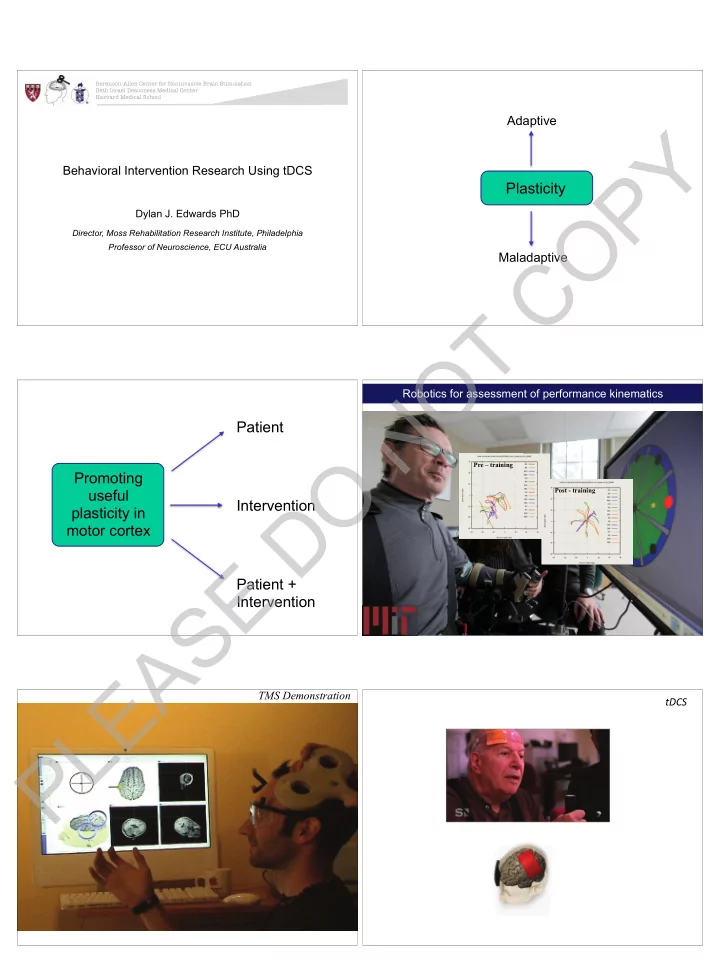

Berenson-Allen Center for Noninvasive Brain Stimulation Beth Israel Deaconess Medical Center Harvard Medical School Adaptive Y P Behavioral Intervention Research Using tDCS Plasticity O Dylan J. Edwards PhD Director, Moss Rehabilitation Research Institute, Philadelphia C Professor of Neuroscience, ECU Australia Maladaptive T O N Robotics for assessment of performance kinematics Patient O Pre – training Promoting Post - training useful D Intervention plasticity in motor cortex E Patient + S Intervention A E TMS Demonstration !"#$ L P
?"'0$8":';8"A0B+%-4"'+$,-./ Y P O C 23$"+45/4",+"0$56)/"-*,/4/**/),78"-"7,0'6%67"564-,0+$"+*"-,"%/-7,"9"'0$"-," :"';"+4"-$"0$,/$70,&"+*"<=>"';"*+4"?"'0$@ T !"#$%&"'()*"'+$,-./"/**/),01/ %&!'()*+*!+,-.+/000 O N O Corticomotor excitability in stroke D E Webster et al (2006) S A E L Functional Improvements TMS correlates P sRT/cRT Resting MT 7%>+62;'-*+&*%,-*.//?* !"#$%&'(%)*+&*%,-*.//0* Pinch force acceleration Transcallosal Inhibition @"AA'"*+&*%,-*.//4* 1%,2"3*+&*%,-*.//4* 5633+,*+&*%,-*.//4* B(+A)'*+&*%,8-*.//:* fingers/thumb AROM 7%,+,,'*+&*%,8-*.//4****9'3* MEP Amplitude B(+A)'*+&*%,8-*.//= Movement accuracy +&*%,8-*.//:*5633+,*+&* 1%)C6(*+&*%,8-*.//=* %,-*.//:*9;+<(*+&*%,8-* 7%>+62;'*+&*%,8-*.//=* Purdue Pegboard .//=*5633+,*+&*%,-* @"AA'"-*+&*%,8-*.//:** .//=** JTT D+(;%;)-*+&*%,8-*.//E* Webster et al (2006) Webster et al (2006) Webster et al (2006) IMPROVED CORTICOMOTOR OUTPUT FROM IPSI-LESIONAL M1 IMPROVED CORTICOMOTOR OUTPUT FROM IPSI-LESIONAL M1 & IMPROVED MOTOR BEHAVIOUR & IMPROVED MOTOR BEHAVIOUR
Anodal tDCS favors clinical improvement in stroke… Y P O C T Butler et al. O N O How does repetitive behavior affect D motor cortex? E S A E L P Motor map does not change unless in skill context Simple repetitive finger movements increase excitability
Y Anodal tDCS prior to excitatory PAS P further boosts How does combined intervention affect excitability, while during tDCS motor cortex? reverses effect to O reduced excitability C Nitsche et al (2007) T O N Anodal tDCS combined with robotic motor training O Is coupling tDCS with training good? D 1mV E Pre-tDCS Post-tDCS Post-Robot S A E Anodal tDCS combined with robotic motor training !"#"$%&'"()*(+,&"-%.,'(-"%/01"/(.)('#,&,'%#(*0&'.,)& L P C+1/'/$,"DB//5"EB/-F8"'/-$G" C+1/'/$,"D'++,H$/77" ;0'" I/10-,0+$" Highest correlation with clinical function Group SICI Index Conditioned / uncond MEP amplitude * p < 0.05 1 * 0.5 0 Pre Post Post “Kinematic Robot-Based Evaluation Scales and Clinical Counterparts to Measure Upper tDCS tDCS Robot Limb Motor Performance in Patients With Chronic Stroke” (Bosecker et al, 2009) Edwards et al (2009)
Key Findings: Effect of Intervention on Motor Performance 2)$"-"&.(31%,&,&4(5%1%6,4- K076-%"L6/"M"N//5A-)F Training Training + Training + Training + Alone tDCS (pre) tDCS (during) tDCS post Y 20 P 11 Normalised data (%) J-$5"B+70,0+$ 1203004 1203005 neutral extension 2 ;0' C/-$"DB//5 B/47+$"-),01/8" O '-)H0$/"B-7701/ C/-$"DB//5 D'++,H$/77 1203056 120307/ 8+%9+(),:;*++ -7 <*=&,!&9: B/47+$"B-7701/8" C 4+A+,"-),01/ -16 Significant improvement Significant decrement T O<'0$78"<POJQ"'+1/'/$,"ER'0$7"'+1,8":"'0$"4/7,G"SR Group Data n=12 Giacobbe et al., (2013) O N Timing of tDCS and behavioral therapy !"#$'*(%+,)-%./')0"&)1.2.#3)"0)&145)+#/)6'7+8."&+,)17'&+*9) !"#$%&'(')*+,,',,-'./0*1232/*45,*678* ;:1<:=)5>55:?=)) !"#$%&&'#()) !"#$% FM (max 66) &"% O !"#$% &"% D :#('&,'+8'/) Usual care !"#$% &"% !"#$% &"% $'()*+%#,-)*% 5'@%'#A+,)) E !"#$% &"% 6./'.,:4'*72-=9):,2.*8<')9=(*>678?* 1232/*9,,:,/';*/<')9=(* S 6>1;>>=)5>55:?=)) ./0!)+%123)%% !"#$% &"%% * 36 session protocol chronic stroke Lo et al, NEJM (2010) A E L P H 1 : Robot +tDCS > Robot + SHAM tDCS on UEFM improvement Combined tDCS-Robotic Training Study Design Training Period Edwards et al (2009) EVAL. EVAL. EVAL. EVAL. EVAL. 3x / wk, 12 weeks, 36 sessions 1 hour shoulder/elbow/wrist robotic training Group SICI Index Giacobbe et al (2013) Conditioned / uncond tDCS or sham pre training (2 groups) MEP amplitude 1 wk 1 wk 6 months * p < 0.05 1 • 82 patients, right hemiparesis * • >6 mnths post first ischemic stroke 0.5 • Robotic protocol alternates S/E-wrist robot across sessions • tDCS 2mA, 35cm 2, 0.9% NaCl soaked sponges 0 Pre tDCS Post tDCS Post Robot
Y P O C T *Edwards et al. Accepted O N Infarct + O ! Parameters: Pars triangularis D • 2 runs of 20 minutes of cathodal stimulation • Electrode placement Cathode – R pars triangularis • Anode – L supraorbital region E • • Real – direct current of 2 mA • Sham – direct current of 0.1 mA S Northstar Trial • Worn during speech therapy A E ,ILD"*+4"-BH-70-"4/H-A0%0,-,0+$"" L • " B40'-40%&"7,650/5"-7"-")+'B%/'/$,",+"7B//)H",H/4-B& P 2).)1 789%/,% .@AB(G"*)1"(B3 ;< .@AB(C(D)(53EF3 :;< .@AB(@01,&4(53EF3 H:< .@AB(@01,&4(B3 .@AB(G"*)1"(53EF3 ?:< =>< O<:RTO<:?"U6A%0)-,0+$7
1x HD Anode Y A. P B. O C. C 4x HD Return Electrodes T O N C3 Peak = 163 V/m C3 Peak = 96 V/m 1000V TES 1000V TES 600V TES CS CS C3 Peak = 5 V/m anterior C3. A (ii). F3 A (i). C2. CS 100µV 20ms C3 Peak = 80 V/m O 200µV FC3 20ms CS C3 Peak = 192 V/m C3 Peak = 240 V/m 480V TES 600V TES CS CS D B (i). B (ii). C3 Peak = 163 V/m C3 Primary Motor Cortex CS C3 Peak = 53 V/m E C3 Peak = 144 V/m C3 Peak = 216 V/m 400V TES 600V TES CS CP3 CS CS A2. C (i). C (ii). S C3 Peak = 8 V/m P3 CS posterior Electric field/Current density Electric field/Current density 0 33% 66% Peak 0 33% 66% Peak A (335V/m) E L Net Biological response to DC field in human tissue with tDCS P (MEP amplitude v time) Physical presence of DC field in human tissue with Note: Theoretical tDCS (magnitude v time) Lasting effect MEP amplitude intensity onset time onset time Courtesy StarLab
Opposing homeostatic Y forces Opposing homeostatic P forces O intensity C Reverse onset effects time Webster et al (2006) T O N O = J D E F M S !"#$%&'()'*+,-.&'/+0+'12%'-+3&40'5"06'72%37+.89$:72%37+.'90%2;&'<=>'+?"+.'@A'BCD'5"06'.&E'72%37+.89$:72%37+.' 90%2;&'+4/'<F>'90%2;&'.&9"24',+9;'&,-.2G&/'12%'H$+430+3I&'+4+.G9"9'21'"41+%7324'I2.$,&''<J>'@2-2#%+-6"7' ,+-9'21'@B*',202%'&I2;&/'-20&43+.9'12%'=KF'+4/82%'LMJ'6+4/',$97.&9'21'$4+N&70&/'6&,"9-6&%&'<%"#60>' +4/'<M>'+N&70&/'6&,"9-6&%&'<.&E>)'C&9-249&'+,-."0$/&9'+%&'42%,+."O&/'1%2,',"4",$,'<%&/>'02',+?",$,' <56"0&>)''P%+G'"9'42'%&9-249&)'' A E L P * Gerber et al, 2019
Thank you Y P O C T O N O D E S A E L P
Recommend
More recommend